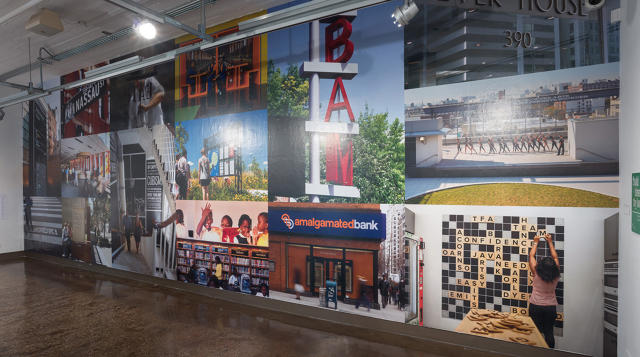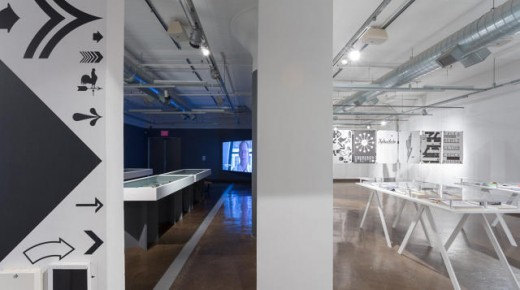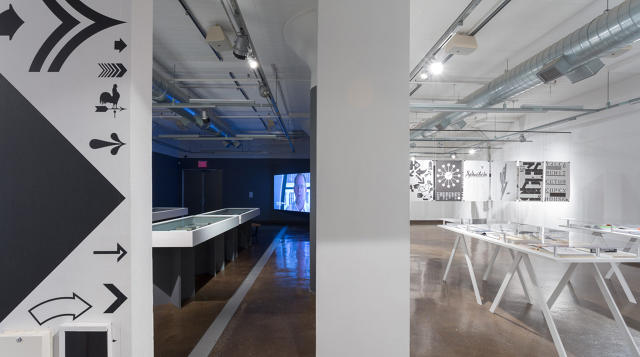Michael Bierut On How Graphic Design Can Accomplish Close To Anything
The acclaimed designer talks to Co.Design on the occasion of his new exhibition and monograph.
When he was in high school in the 1970s, Michael Bierut trekked from his hometown—a suburb south of Cleveland, Ohio—to New York City. “The only souvenir I brought back was the Vignelli subway map,” he recalls. “My friends would have pictures of rock stars and Farrah Faucet on their walls and I had this subway map to a city I’d been to once. It had a talismanic quality to me.”
The rest, as they say, is history. Bierut worked in the legendary office of Massimo and Lella Vignelli for 10 years before joining Pentagram in 1990. He’s been there ever since, steadily rebranding and reshaping the visual identity for virtually…everything.
Rattling off the entire list of Bierut’s projects is an exercise in futility since there are simply so many, but here’s a start: the WalkNYC wayfinding signage; MIT Media Lab identity; shopping bags for Saks Fifth Avenue; posters for the Yale School of Architecture; Billboard’s logo. Chances are you’ve encountered his work.

It’s a banner year for Bierut as the School of Visual Arts selected him for its prestigious Masters Series—an annual award for visual communication that also encompasses a solo gallery show (which is on view at the SVA Chelsea Gallery until November 7) and artist talk (which takes place on October 14).
Moreover, he’s just released a monograph brimming with work from five decades of his life. Called How to Use Graphic Design to Sell Things, Explain Things, Make Things Look Better, Make People Laugh, Make People Cry, and (Every Once in a While) Change the World (Harper Design, 2015), the book is part manifesto, part design guide, and wholly a look into how Bierut’s mind works.
The chapters are relayed as problem solvers. “How to invent a town that was always there” is the header for a chapter about creating the graphics for Celebration, Florida, a New Urbanist city. Bierut distills his work for Princeton University’s development department—a fundraising entity—as “How to raise a billion dollars.” The explanations are refreshingly jargon-free, conversational, and filled with the designer’s humble enthusiasm.

Bierut spoke with Co.Design about this seminal moment in his career, how rejection breeds better design, and taking a culinary approach to his work.
Co.Design: There’s plenty to chew on with the book and exhibition, but what are you looking forward to next?
Michael Bierut: When you do this sort of thing—assembling a book and an exhibition—it actually is putting up some sort of dividing line whether you want it to or not. It’s like the first act curtain, you hope. And then in a way it gives you license to think about what you want to do next and if you want to do something different next. And so one thing I’m looking forward to is figuring that out.
When I was doing the book, I thought about year by year what had happened to me since I was a little kid. I realized I’m one of these people who desperately clings to this idea of continuous forward motion. Literally the Monday after I graduated, I started at VIgnelli Associates. I worked there for 10 years then I quit on a Friday and the next Monday I started at Pentagram. And I’ve taken vacations and stuff, have been married to the same woman during that whole period, raised three wonderful kids, had and plenty of time off. But sort of the idea that you would actually stop and take a deep breath is on some level really terrifying to me. You’re not sure you’d be permitted to start again.
One of the anecdotes you share in the book is a moment when you were six years old and your father explains the symbolism of a logo on a forklift, which unlocks this “secret language” of graphic design. Do you still have those “aha” moments today?
I still will do that thing graphic designers do where they go to bookstores. You can always tell a graphic designer at a bookstore because they pick up books, they flip to the back flap to see who did the cover, then they put the book back, and they pick up another book, and put it back. I’ll still see beautiful book covers.
I saw the big four-page insert they did for the Steve Jobs film in the New York Times or something. I thought this is such great self control! It’s all white, they had the audacity to channel the subject of the film really perfectly. Of course it was disappointing to see how they—in true Hollywood style—they have four versions of promotional language. There’s another one I saw that looks nothing like that.
Is there anything you haven’t worked on that you would really like to?
I actually feel really lucky because I’ve had this oddly reactive career. I’ve done self-initiated projects and a lot of times I don’t really think of them as design projects. They have to do with just some subject I’ll get interested in and I’ll just concoct some excuse to do a project about it.
At Pentagram we do these things called Pentagram Papers. The last one we did was Errol Morris who analyzed typefaces and systematically proved that Baskerville was the ideal font. I worked on that for like a year and a half. It wasn’t so much so much something I wanted to design; I just loved his writing. If someone had asked me in 1980, as the lights came up right after I saw the Thin Blue Line, “Would you like to work with that director on a project?” I would say, oh God I would do anything. But instead, one day the phone just rang and it was really great. I’ve been lucky not wishing anything consciously—not daring to wish anything consciously—and one day the phone just rings.
I was one the record as saying—and it’s all a matter of taste—that my least favorite logo in the world was Verizon and all of a sudden someone I knew called and said, “I have this new job. I work at Verizon now. Can I come talk to you?” It was just lucky.
And this is advice that anyone can use. You do really good work when it’s something you care about and you’re interested in it. Someone asked me if I ever did an architecture book I wasn’t happy with, and I’ve done a number of books that aren’t my favorite and in every case it was something I wasn’t interested in. And so a lot of people interpret it the wrong way as, “What am I passionate about, what’s that one thing? I’ll focus on that.” Instead, the people who do well in graphic design particularly—I don’t think this is necessarily true of the other design disciplines—but in graphic design it’s really important that the more things you can be interested in, the more things you’ll design well. If you decide it’s going to be skateboard graphics or nothing, well good for you if you can make a life doing that. If you’re happy more power to you, that’s great. But instead, someone says you want to do the signs for the New York Times? I can convince them that to do the work properly, I have to talk to editors, I have to sit in on the page-one meeting where they decide how page one is going to be laid out. They indulged me.
So it’s kind of like taking a method actor approach to graphic design.
A little bit. If you just have a request for proposal where the client says we need X, Y, and Z, that really just gives you the shopping list. If you’re lucky enough to get that project, figuring out what the brief is, everyone needs X, Y, and Z. It’s sort of like saying, I need a pair of pants and a shirt. But then, where are you going to wear it, how much are you going to spend? I’ll stand you in front of a mirror and you have to feel like you’re the kind of person who can wear those clothes.
So going to all those meetings, if all I cared about were typefaces or colors, I’d be sitting, fidgeting, thinking, “Why am I here? This is boring.” Instead, I was thinking “I can’t believe I’m here, I can’t believe that without ever taking a journalism class I’m actually sitting with the top editors at the New York Times and I’ll know before any other civilian does what’s going to be the story that appears in the first column on the left of tomorrow’s paper. I had that momentary thrill.
It was an insight that, in a way, sort of made you sense that the people who work there take it really personally. I came to realize was that they really loved and felt at home in the old building and going into the Renzo Piano and Gensler building seemed cold and unfamiliar. It was a feeling of, “What happened to the New York Times that I love?”
The person doing the bathroom signs [editor’s note: the signs feature images from the paper’s photo archives] can’t bear that burden entirely, but by sort of acknowledging that we’re not doing off-the-rack things here, we’re sort of reaching into your history a little bit, I think that actually gave some people some reassurance that, with other gestures, added up to something nice. I don’t think we would have done that if we just were sort of filling out a brief and asking how many signs, where do they go, what’s the budget—that doesn’t answer those questions.
In one of the notebooks on view, there’s a page with a manifesto about clients and one of the phrases says, “Don’t Educate the Client.” Can you tell me about that philosophy and how it impacts your work?
Designers undergo in design school and in their early years this process of transformation that they tend to forget about. They start out as normal people and the acquire this hyper sensitivity to things that are invisible to normal people. And it’s necessary because that’s how they’re going to be exercising their craft properly, how they’ll solve the problems, and create things.
The very building blocks of graphic design are very complex and encoded and so we learn all those things. And then because it’s about communication, because it’s a social activity, it’s a civic activity, it happens among people, out in the world that means you need clients and an audience. I need to know what I’m communicating, to whom I’m communicating, on whose behalf I’m communicating, what they’re supposed to do with the communication.
When I started out, I remember just resenting the lack of sophistication of my clients. My hypersensitivity made me arrogant, I sort of forgot that I’d spent five years kind of trying to transform myself from this normal person to this abnormal person. I started blaming other normal people for being normal instead of forgiving them for not realizing that I now have this body of knowledge and set of skills that no one else has.
I come up with a sophisticated solution, the client is insufficiently sophisticated to appreciate it, but I can fix that. All I have to do is somehow “educate” my client so he or she will realize that I was right all along, do what I tell them and we’ll all go happily ever after.
Now every time I’ve been in front of a client, and the solution is not being accepted—I pick my clients carefully, and work for smart people who do things I admire and are in some way or another making the world a better place— I just assume if what I’m doing is missing the mark, it’s much more likely that I’ve missed something. It’s not that they’re not appreciating this thing I’ve done with typography. I just always assume it’s my responsibility to educate myself, figure out what is it that I’ve missed here, what is it that I’ve failed to connect.
There are chapters in the book where I talk about rejected solutions. Someone asked if I put in those rejected solutions because I liked them better. I put them in to show how dangerous it would’ve been if my client accepted the first thing I showed. “Just because I’m brilliant, here take this.”
At any point in your career, did you think it was important to have a style?
I’ve neither resisted that or yearned for that. I can see sort of the benefits of “having a style.” If you’re an architect, I think you really have to commit to an approach that the work you’re doing is so high stakes, it’s so long term, you don’t have the luxury of trying something on Monday and another thing Tuesday. Only a few architects—who were quite criticized for it—would change it up like that. For example, Philip Johnson and his whole career, but especially in his later years during the postmodern era of the anything-goes 1980s. But most architects, I think, would be undermining their own practice if they thought about switching it up all the time.
In graphic design, the stakes are so much lower, the turnaround is so much quicker, you can experiment with something, try it out, discard it if it doesn’t work. On the other hand, I think the only time style is good for a graphic designer is if you just have a default position, if you have nothing else to bring to the table, if you just have that thing you can do because that’s what you do. And I know a couple designers who sort of have the default position they can fall back on.
I have to admit I don’t have that “Michael Bierut thing.” At least I don’t think so, but just the other day someone was talking to me and they asked me about three projects, all of which are represented in that first room of the exhibition, all of which are in the book. One is the sign in front of the New York Times building, the other one is Sacks Fifth Avenue, the third was BAM. In every case there’s a moment I say, “Then I took it and cut it into a lot of parts.” And I have to admit I might be some frustrated chef because there’s something about that kind of slicing and dicing!
Hugh Hardy, who’s been a consultant to BAM a little bit longer than I have, called it “cuisine art typography” when I started cutting off the tops of bottoms and sides of News Gothic. Just put it in and chop it up.
To the degree of a cooking metaphor, nothing makes me happier than having a ready-set-cook situation where someone says, in the fridge you’ll find a head of lettuce a jar of peanut butter, three hot dogs, and some brown sugar, make something out of that. To say, look we have this logo, these names, what can we do? There’s something really, really interesting. I don’t have so much a style in the way things end up looking, but I have methodologies that I use really consistently.
I’m the opposite of the kind of designer who needs an empty table and a blank slate to work. Anything I think we can use to build to the next stage of design I’m really happy to have. The MIT Media Lab identity is perceived of as being brand new, but it’s built on the same grid as the identity that immediately preceded it. It’s self consciously meant to channel the work Muriel Cooper and Jacqueline Casey did for MIT back in the 60s, 70s, and 80s. It also represents a conscious decision to simulate the world of course bitmap video game as opposed to trying to do the next big MIT will do. We were given a blank slate, but each reference point made me feel more secure about the situation.
What do you think a good poster, a good book, or a good package design embodies?
They’re all different but I have to admit that every job that I’ve done that actually came out well, there is this moment where it’s like you just have all these keys and the key fits into a lock and you turn it and you feel the lock open and the door opens and it’s so…nice.
I’ve done projects where I’ve basically had to Jimmy the door; where I’ve had to take the door off its hinges; where I’ve had to kick it in; or break the window, reach around, and open it that way. You try to clean up after yourself so people don’t notice that force was used, but sometimes you’re not lucky. The ones that are my favorites are the ones where suddenly somehow you miraculously find that key and the door opens.
I can almost tell by looking at something if that designer’s key worked in that particular lock. When it does, it seems so sweet and nice and beautiful. It has nothing to do with style, nothing to do with normal standards of beauty, sometimes it can be ungainly or outright ugly, but if it’s just perfect for what it is, there’s a kind of ease with it. That sense that it is kind of right—however defined—is something people can, in a really deep subconscious way, can kind of sense. What I like about it is, it doesn’t have to cost more, it doesn’t mean it’s fancy, it’s exclusive, it just mans someone kept trying the keys until they found it in that particular lock. Now you can walk through that door.
[All Photos (unless otherwise noted): Stan Narten via SVA Galleries]
Fast Company , Read Full Story
(96)



